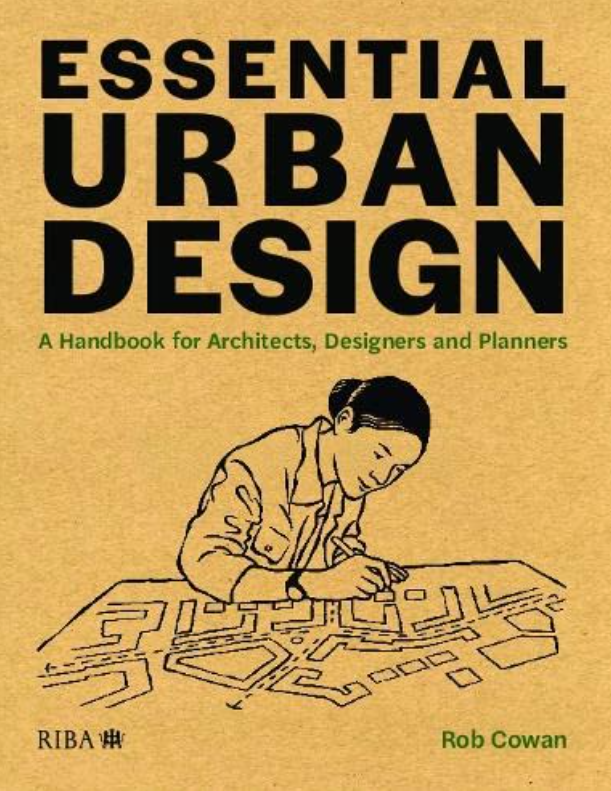Essential Urban Design

|
| Essential Urban Design, Rob Cowan, RIBA Publishing, 2021, 218 pages, extensively illustrated. |
There have always been tensions in the planning system over the importance of design. These are apparent in the government’s publication of the National Design Guide 2021 on the one hand, but expansion of permitted development rights on the other. This book by Rob Cowan is a timely publication, targeted at architects, designers and planners. It could also be useful to communities, such as those involved in community planning and projects.
The book is well illustrated and clearly written. It places emphasis on urban design as an essential part of good planning, addressing key land use issues; for example, the need for housing to be supported by community facilities and services.
Chapter 1 is a really useful history of the development of urban design and planning thinking and practice, with reference to many pioneers, theorists and practitioners (from Vitruvius onwards). This provides a useful foundation and summary for the remainder of the book.
Chapter 2 deals with key objectives or elements of urban design, including building design and landscape design, and also touches on things like infrastructure, management, maintenance, and adaptability and biodiversity. Chapter 3 addresses context and character, including physical and social, economic, political and cultural factors.
Chapter 4 addresses politics, collaboration and the role of local authorities. This deals with decision-making processes within a democratic context. There is an interesting discussion of motivations for professionals, from application of professional expertise to more collaborative approaches. The chapter includes practical guidance on how local planning authorities can maintain design quality, supported by an interesting diagram of deteriorating jellies. Design statements and design review are also addressed.
Chapter 5 deals with strategic urban design and master planning. Strategic urban design is illustrated by the Glasgow Development Agency and redevelopment of the Gorbals, and various other examples, demonstrating how urban design often needs to be considered over a wide area and extensive timescale. The chapter lists common reasons for master planning failures, and there is material on design codes.
The book is illustrated throughout, with real-world examples, and useful lists of what to do – and what not to do. It concludes with a list of 10 urban design essentials, based on the previous chapters.
There is no shortage of books on urban design, from theory to practical guidance, including some classic but also lengthy texts. Collectively this could be overwhelming for time-pressed people, including development managers and neighbourhood planning bodies. A clear, concise and accessible guide is therefore a more realistic prospect, and this book hits the nail.
If I were to recommend one book to anyone wishing to learn about urban design, this would be it. Equally, for those more experienced in the topic, it is a useful summary and refresher, complete with practical checklists.
This article originally appeared as ‘Design in the real world’ in the Institute of Historic Building Conservation’s (IHBC’s) Context 174, published in December 2022. It was written by Dave Chetwyn, Urban Vision Enterprise CIC.
--Institute of Historic Building Conservation
Related articles on Designing Buildings
- Boom Cities: architect-planners and the politics of urban renewal in 1960s Britain.
- Conservation.
- Heritage and urban design in Tamaki Makaurau / Auckland.
- Heritage.
- Historic environment.
- IHBC articles.
- Institute of Historic Building Conservation.
- Listed buildings.
- Securing Urban Heritage: agents, access, and securitization.
- Strategic urban design and the conservation team.
- Urban Heritage, Development and Sustainability.
IHBC NewsBlog
SAVE celebrates 50 years of campaigning 1975-2025
SAVE Britain’s Heritage has announced events across the country to celebrate bringing new life to remarkable buildings.
IHBC Annual School 2025 - Shrewsbury 12-14 June
Themed Heritage in Context – Value: Plan: Change, join in-person or online.
200th Anniversary Celebration of the Modern Railway Planned
The Stockton & Darlington Railway opened on September 27, 1825.
Competence Framework Launched for Sustainability in the Built Environment
The Construction Industry Council (CIC) and the Edge have jointly published the framework.
Historic England Launches Wellbeing Strategy for Heritage
Whether through visiting, volunteering, learning or creative practice, engaging with heritage can strengthen confidence, resilience, hope and social connections.
National Trust for Canada’s Review of 2024
Great Saves & Worst Losses Highlighted
IHBC's SelfStarter Website Undergoes Refresh
New updates and resources for emerging conservation professionals.
‘Behind the Scenes’ podcast on St. Pauls Cathedral Published
Experience the inside track on one of the world’s best known places of worship and visitor attractions.
National Audit Office (NAO) says Government building maintenance backlog is at least £49 billion
The public spending watchdog will need to consider the best way to manage its assets to bring property condition to a satisfactory level.
IHBC Publishes C182 focused on Heating and Ventilation
The latest issue of Context explores sustainable heating for listed buildings and more.

















Comments
[edit] To make a comment about this article, or to suggest changes, click 'Add a comment' above. Separate your comments from any existing comments by inserting a horizontal line.